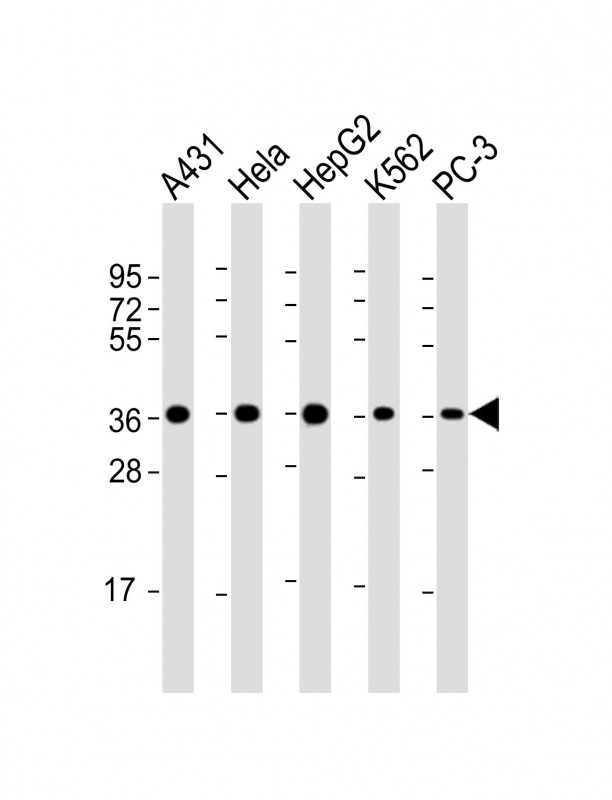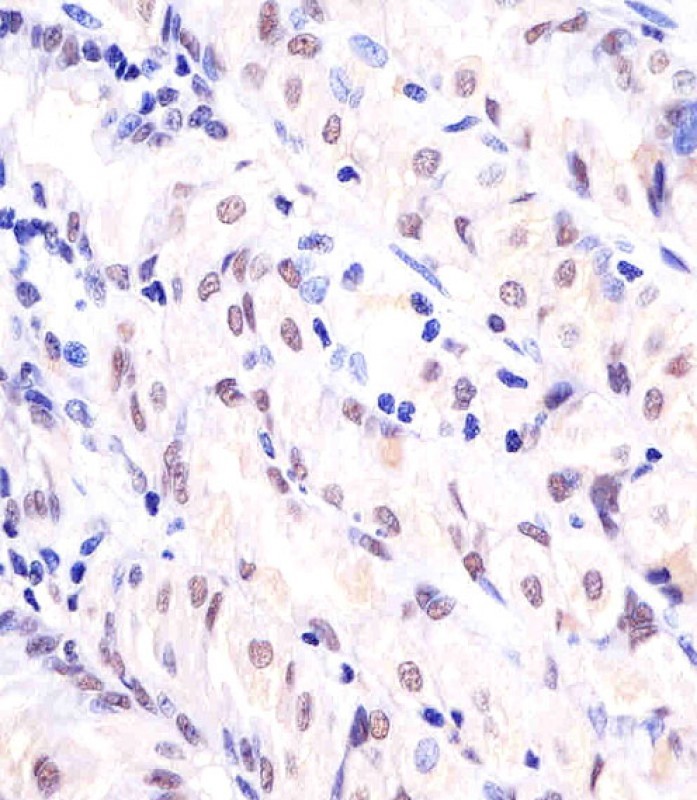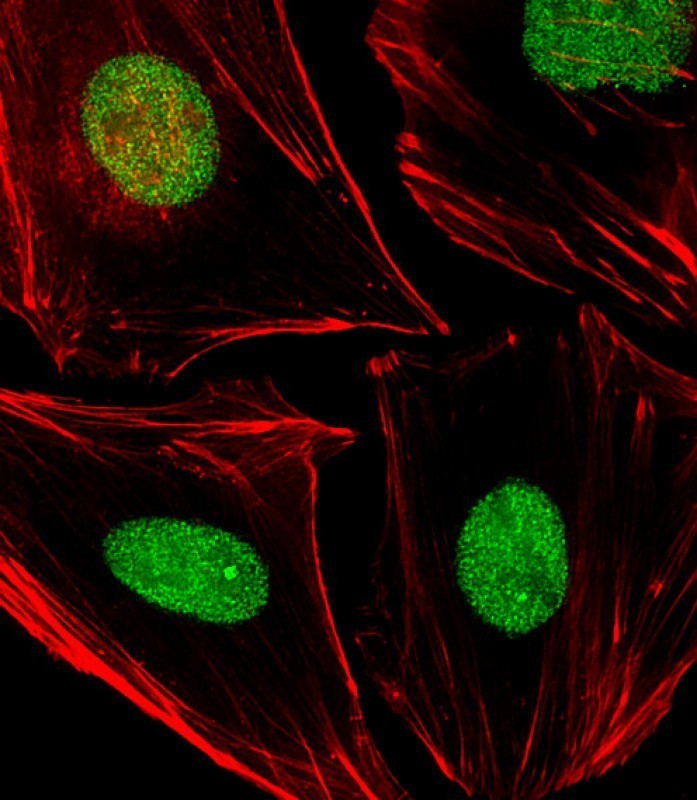
Mouse Anti-APEX1 antibody
APEX1_HUMAN; DNA-(apurinic or apyrimidinic site) endonuclease; EC:3.1.11.2; APE; APE1; APEX; APX; HAP1; REF1; APEX nuclease (APEN); Apurinic-apyrimidinic endonuclease 1 (AP endonuclease 1; APE-1); REF-1; Redox factor-1; DNA-(apurinic or apyrimidinic site)
View History [Clear]
Details
Product Name APEX1 Chinese Name 多功能DNA修复酶单克隆抗体 Alias APEX1_HUMAN; DNA-(apurinic or apyrimidinic site) endonuclease; EC:3.1.11.2; APE; APE1; APEX; APX; HAP1; REF1; APEX nuclease (APEN); Apurinic-apyrimidinic endonuclease 1 (AP endonuclease 1; APE-1); REF-1; Redox factor-1; DNA-(apurinic or apyrimidinic site) endonuclease, mitochondrial; Research Area Cardiovascular Chromatin and nuclear signals transcriptional regulatory factor Immunogen Species Mouse Clonality Monoclonal Clone NO. F9S3 React Species Human, Applications WB=1:500-4000 IHC-P=1:25 IHC-F=1:25 ICC=1:25 IF=1:25 (Paraffin sections need antigen repair)
not yet tested in other applications.
optimal dilutions/concentrations should be determined by the end user.Theoretical molecular weight 36kDa Cellular localization The nucleus cytoplasmic Form Liquid Concentration 1mg/ml immunogen Recombinant human APEX1. Lsotype IgG1,κ Purification affinity purified by Protein G Buffer Solution 0.01M TBS(pH7.4) with 1% BSA, 0.03% Proclin300 and 50% Glycerol. Storage Shipped at 4℃. Store at -20 °C for one year. Avoid repeated freeze/thaw cycles. Attention This product as supplied is intended for research use only, not for use in human, therapeutic or diagnostic applications. PubMed PubMed Product Detail The APEX gene encodes the major AP endonuclease in human cells. It encodes the APEX endonuclease, a DNA repair enzyme with apurinic/apyrimidinic (AP) activity. Such AP activity sites occur frequently in DNA molecules by spontaneous hydrolysis, by DNA damaging agents or by DNA glycosylases that remove specific abnormal bases. The AP sites are the most frequent pre-mutagenic lesions that can prevent normal DNA replication. Splice variants have been found for this gene; all encode the same protein. Disruptions in the biological functions related to APEX are associated with many various malignancies and neurodegenerative diseases.[provided by RefSeq, Dec 2019]
Function:
Multifunctional protein that plays a central role in the cellular response to oxidative stress. The two major activities of APEX1 in DNA repair and redox regulation of transcriptional factors. Functions as a apurinic/apyrimidinic (AP) endodeoxyribonuclease in the DNA base excision repair (BER) pathway of DNA lesions induced by oxidative and alkylating agents. Initiates repair of AP sites in DNA by catalyzing hydrolytic incision of the phosphodiester backbone immediately adjacent to the damage, generating a single-strand break with 5'-deoxyribose phosphate and 3'-hydroxyl ends. Does also incise at AP sites in the DNA strand of DNA/RNA hybrids, single-stranded DNA regions of R-loop structures, and single-stranded RNA molecules. Has a 3'-5' exoribonuclease activity on mismatched deoxyribonucleotides at the 3' termini of nicked or gapped DNA molecules during short-patch BER. Possesses a DNA 3' phosphodiesterase activity capable of removing lesions (such as phosphoglycolate) blocking the 3' side of DNA strand breaks. May also play a role in the epigenetic regulation of gene expression by participating in DNA demethylation. Acts as a loading factor for POLB onto non-incised AP sites in DNA and stimulates the 5'-terminal deoxyribose 5'-phosphate (dRp) excision activity of POLB. Plays a role in the protection from granzymes-mediated cellular repair leading to cell death. Also involved in the DNA cleavage step of class switch recombination (CSR). On the other hand, APEX1 also exerts reversible nuclear redox activity to regulate DNA binding affinity and transcriptional activity of transcriptional factors by controlling the redox status of their DNA-binding domain, such as the FOS/JUN AP-1 complex after exposure to IR. Involved in calcium-dependent down-regulation of parathyroid hormone (PTH) expression by binding to negative calcium response elements (nCaREs). Together with HNRNPL or the dimer XRCC5/XRCC6, associates with nCaRE, acting as an activator of transcriptional repression. Stimulates the YBX1-mediated MDR1 promoter activity, when acetylated at Lys-6 and Lys-7, leading to drug resistance. Acts also as an endoribonuclease involved in the control of single-stranded RNA metabolism. Plays a role in regulating MYC mRNA turnover by preferentially cleaving in between UA and CA dinucleotides of the MYC coding region determinant (CRD). In association with NMD1, plays a role in the rRNA quality control process during cell cycle progression. Associates, together with YBX1, on the MDR1 promoter. Together with NPM1, associates with rRNA. Binds DNA and RNA.
Subunit:
Monomer. Homodimer; disulfide-linked. Component of the SET complex, composed at least of APEX1, GZMA, SET, ANP32A, HMGB2 and NME1. Associates with the dimer XRCC5/XRCC6 in a DNA-dependent manner. Interacts with SIRT1; the interaction is increased in the context of genotoxic stress. Interacts with HDAC1, HDAC2 and HDAC3; the interactions are not dependent on the APEX1 acetylation status. Interacts with XRCC1; the interaction is induced by SIRT1 and increased with the APEX1 acetylated form. Interacts with NPM1 (via N-terminal domain); the interaction is RNA-dependent and decreases in hydrogen peroxide-damaged cells. Interacts (via N-terminus) with YBX1 (via C-terminus); the interaction is increased in presence of APEX1 acetylated at Lys-6 and Lys-7. Interacts with HNRNPL; the interaction is DNA-dependent. Interacts (via N-terminus) with KPNA1 and KPNA2. Interacts with TXN; the interaction stimulates the FOS/JUN AP-1 complex DNA-binding activity in a redox-dependent manner. Interacts with GZMA, KRT8, MDM2, POLB, PRDX6, PRPF19, RPLP0, TOMM20 and WDR77. Binds to CDK5.
Subcellular Location:
Nucleus. Nucleus, nucleolus. Nucleus speckle. Endoplasmic reticulum. Cytoplasm. Note=Detected in the cytoplasm of B-cells stimulated to switch. Colocalized with SIRT1 in the nucleus. Colocalized with YBX1 in nuclear speckles after genotoxic stress. Together with OGG1 is recruited to nuclear speckles in UVA-irradiated cells. Colocalized with nucleolin and NPM1 in the nucleolus. Its nucleolar localization is cell cycle dependent and requires active rRNA transcription. Colocalized with calreticulin in the endoplasmic reticulum. Translocation from the nucleus to the cytoplasm is stimulated in presence of nitric oxide (NO) and function in a CRM1-dependent manner, possibly as a consequence of demasking a nuclear export signal (amino acid position 64-80). S-nitrosylation at Cys-93 and Cys-310 regulates its nuclear-cytosolic shuttling. Ubiquitinated form is localized predominantly in the cytoplasm.
DNA-(apurinic or apyrimidinic site) lyase, mitochondrial: Mitochondrion. Note=The cleaved APEX2 is only detected in mitochondria. Translocation from the cytoplasm to the mitochondria is mediated by ROS signaling and cleavage mediated by granzyme A. Tom20-dependent translocated mitochondrial APEX1 level is significantly increased after genotoxic stress.
Post-translational modifications:
Phosphorylated. Phosphorylation by kinase PKC or casein kinase CK2 results in enhanced redox activity that stimulates binding of the FOS/JUN AP-1 complex to its cognate binding site. AP-endodeoxyribonuclease activity is not affected by CK2-mediated phosphorylation. Phosphorylation of Thr-233 by CDK5 reduces AP-endodeoxyribonuclease activity resulting in accumulation of DNA damage and contributing to neuronal death.
Acetylated on Lys-6 and Lys-7. Acetylation is increased by the transcriptional coactivator EP300 acetyltransferase, genotoxic agents like H(2)O(2) and methyl methanesulfonate (MMS). Acetylation increases its binding affinity to the negative calcium response element (nCaRE) DNA promoter. The acetylated form induces a stronger binding of YBX1 to the Y-box sequence in the MDR1 promoter than the unacetylated form. Deacetylated on lysines. Lys-6 and Lys-7 are deacetylated by SIRT1.
Cleaved at Lys-31 by granzyme A to create the mitochondrial form; leading in reduction of binding to DNA, AP endodeoxynuclease activity, redox activation of transcription factors and to enhanced cell death. Cleaved by granzyme K; leading to intracellular ROS accumulation and enhanced cell death after oxidative stress.
Cys-65 and Cys-93 are nitrosylated in response to nitric oxide (NO) and lead to the exposure of the nuclear export signal (NES).
Ubiquitinated by MDM2; leading to translocation to the cytoplasm and proteasomal degradation.
Similarity:
Belongs to the DNA repair enzymes AP/ExoA family.
SWISS:
P27695
Gene ID:
328
Database links:Entrez Gene: 328 Human
SwissProt: P27695 Human
Product Picture
Lane 1: A431 cell lysates
Lane 2: Hela cell lysates
Lane 3: HepG2 cell lysates
Lane 4: K562 cell lysates
Lane 5: PC-3 cell lysates
Primary: Anti-APEX1 (SLM-51609M) at 1/2000 dilution
Secondary: IRDye800CW Goat Anti-Mouse IgG at 1/20000 dilution
Predicted band size: 36 kD
Observed band size: 36 kD
Paraformaldehyde-fixed, paraffin embedded (Human stomach section); Antigen retrieval by boiling in sodium citrate buffer (pH6.0) for 15min; Block endogenous peroxidase by 3% hydrogen peroxide for 20 minutes; Blocking buffer (normal goat serum) at 37°C for 30min; Antibody incubation with (APEX1) Monoclonal Antibody, Unconjugated (SLM-51609M) at 1:200 overnight at 4°C, followed by operating according to SP Kit(Mouse)(sp-0024) instructionsand DAB staining.Hela cell; 4% Paraformaldehyde-fixed; Triton X-100 at room temperature for 20 min; Blocking buffer (normal goat serum) at 37°C for 20 min; Antibody incubation with (APEX1) monoclonal Antibody, Unconjugated (SLM-51609M) 1:25, 90 minutes at 37°C; followed by a conjugated Goat Anti-Mouse IgG antibody at 37°C for 90 minutes,Dylight®554 Phalloidin (red) was used to stain the cell Cytoplasmic actin.
References (0)
No References
Bought notes(bought amounts latest0)
No one bought this product
User Comment(Total0User Comment Num)
- No comment





 +86 571 56623320
+86 571 56623320
 +86 18668110335
+86 18668110335

